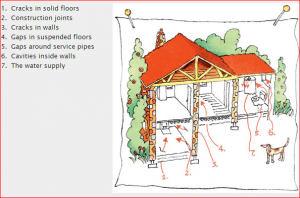What Is Radon? How Does It Get Inside My Home?
go.ncsu.edu/readext?334770
en Español / em Português
El inglés es el idioma de control de esta página. En la medida en que haya algún conflicto entre la traducción al inglés y la traducción, el inglés prevalece.
Al hacer clic en el enlace de traducción se activa un servicio de traducción gratuito para convertir la página al español. Al igual que con cualquier traducción por Internet, la conversión no es sensible al contexto y puede que no traduzca el texto en su significado original. NC State Extension no garantiza la exactitud del texto traducido. Por favor, tenga en cuenta que algunas aplicaciones y/o servicios pueden no funcionar como se espera cuando se traducen.
Português
Inglês é o idioma de controle desta página. Na medida que haja algum conflito entre o texto original em Inglês e a tradução, o Inglês prevalece.
Ao clicar no link de tradução, um serviço gratuito de tradução será ativado para converter a página para o Português. Como em qualquer tradução pela internet, a conversão não é sensivel ao contexto e pode não ocorrer a tradução para o significado orginal. O serviço de Extensão da Carolina do Norte (NC State Extension) não garante a exatidão do texto traduzido. Por favor, observe que algumas funções ou serviços podem não funcionar como esperado após a tradução.
English
English is the controlling language of this page. To the extent there is any conflict between the English text and the translation, English controls.
Clicking on the translation link activates a free translation service to convert the page to Spanish. As with any Internet translation, the conversion is not context-sensitive and may not translate the text to its original meaning. NC State Extension does not guarantee the accuracy of the translated text. Please note that some applications and/or services may not function as expected when translated.
Collapse ▲About Radon
Radon is an odorless, tasteless and invisible gas that occurs in all our natural environments- indoor and outdoor. Radon is produced by the natural decay of uranium(U). Uranium is a radio-active element present naturally in water, soil and rocks as any one of its three isotopes (in simple words this means “forms”). The isotopes are naturally unstable and hence decay or change into a new different element while giving out energy in the form of radiation. U-238 is the most predominant isotope of uranium and radon gets formed after a series of decays of this isotope. However, radon is also radioactive (and hence unstable) and decays further into other elements until it forms a stable end product, which is lead. For a simple, interesting and detailed understanding about uranium decay into radon click here.
How does Radon enter a home
Uranium being present naturally in water and soils, radon gets produced naturally too wherever the uranium may be present. Once produced, radon moves up through the ground (soil) and into the atmosphere. Since, a home’s foundation is on the ground, it travels inside the home through cracks and crevices which might be present in the foundational structure of the home. Once inside the home it keeps getting accumulated and the rising levels lead to a radon problem. All homes- old and new, howsoever tightly they may be built, always have some cracks and crevices and thus can have radon problems. The diagram below depicts different routes radon gas may take to enter a home.
Source: U.S.EPA, 2012
Although, radon enters a home through soil in most cases, it may enter a home through water too. If the water supply for a home comes from ground water i.e. either a well, or if the tap water is sourced from a well by the local utility, then radon gets released in the indoor environment of the home when the water is used for any purpose.
It is estimated that 1 out of every 15 homes in the U.S.have a radon problem (U.S. EPA, 2012). The only way to know if the problem exists in a home is to test for it.
The good news about radon problem is that it can be fixed!! After testing, if it is found that the levels are high, simple appropriate measures can be taken to reduce or stop the flow of radon into the home. These days many homes are being built with radon-resistance features. Incorporating these features at the time of construction itself helps to keep the costs low and makes the technique more effective.
One should always be concerned about radon in one’s home because elevated levels are known to cause lung cancer. One might be surprised to know that currently, radon is known to be the second highest reason of lung cancer deaths in the U.S. after smoking.
Video on Radon by American Lung Association
References: U.S.EPA. (2012). A Citizen’s Guide to Radon: The Guide to Protecting Yourself and Your Family From Radon. Retrieved January 20, 2015, from http://www.epa.gov/radon/pubs/citguide.html.



